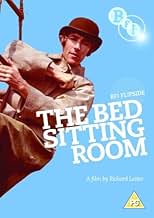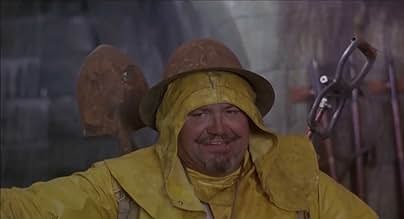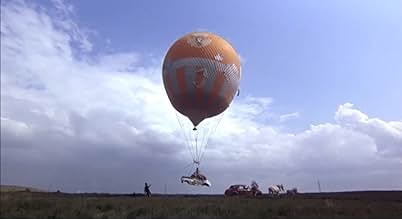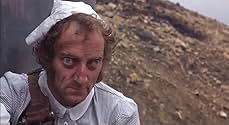AVALIAÇÃO DA IMDb
6,1/10
2,8 mil
SUA AVALIAÇÃO
Adicionar um enredo no seu idiomaPost-apocalyptic England. Survivors navigate surreal wasteland, mutating into inanimate objects. Girl living on train meets commuter and doctor. Follows their interactions amidst chaos, focu... Ler tudoPost-apocalyptic England. Survivors navigate surreal wasteland, mutating into inanimate objects. Girl living on train meets commuter and doctor. Follows their interactions amidst chaos, focusing on girl's pregnancy.Post-apocalyptic England. Survivors navigate surreal wasteland, mutating into inanimate objects. Girl living on train meets commuter and doctor. Follows their interactions amidst chaos, focusing on girl's pregnancy.
- Direção
- Roteiristas
- Artistas
- Prêmios
- 2 vitórias e 3 indicações no total
Avaliações em destaque
Richard Lester's directorial career went into nose-dive (at least for a while) after making this film, which was a pity. It's a post-apocalyptic black comedy like no other. Typically British and typically Milligan-ish, with a stunning visual sense.
What I enjoy most about this film is its uncompromising weirdness. It's incredibly inventive, if not particularly funny, and also quite depressing - but it has to be, dealing with the aftermath of nuclear war.
There are some excellent performances from a cast which seems to contain most of the outstanding British comedy talent of the last thirty years (Marty Feldman is particularly fine) and some pointed satire about the British "stiff upper lip", but it's the surreal visuals which stand out, including the remains of a motorway with hundreds of cars half-buried in mud, and an escalator emerging into a landscape almost entirely composed of broken crockery.
A flawed masterpiece.
What I enjoy most about this film is its uncompromising weirdness. It's incredibly inventive, if not particularly funny, and also quite depressing - but it has to be, dealing with the aftermath of nuclear war.
There are some excellent performances from a cast which seems to contain most of the outstanding British comedy talent of the last thirty years (Marty Feldman is particularly fine) and some pointed satire about the British "stiff upper lip", but it's the surreal visuals which stand out, including the remains of a motorway with hundreds of cars half-buried in mud, and an escalator emerging into a landscape almost entirely composed of broken crockery.
A flawed masterpiece.
This is a movie that has followed me all throughout my life even though I have only watched it one time approx. 22 years ago. The classic British humor in this prepared me to enjoy other comedy such as Monty Python. I am new to the net and am desperately trying to purchase a copy of this masterpiece to dedicate to the now deceased friend I had watched it with years ago. Any suggestions would be appreciated.
A very strange film, this one, a surreal post-apocalypse comedy with some broad satire aimed at British politics and culture. It's quite unmissable on account of the incredible cast of famous faces and worth seeing just for them doing their bit, but the rest is more of a sketch show than anything else. It's moderately funny, on par with a typical MONTY PYTHON episode of the era.
After the grim realism of Peter Watkins' 'The War Game' this film marked the sixties' headlong retreat into total fantasy in which the Central Line still functions and radiation causes mutation into a bed-sitting room rather than boring old radiation sickness.
An amazing cast - including two Goons - make complete fools of themselves in the film in which Dick Lester blew once and for all blew all the professional capital he'd made directing the Beatles.
Ken Thorne's music like the rest of the film is likeable but far too emphatic.
An amazing cast - including two Goons - make complete fools of themselves in the film in which Dick Lester blew once and for all blew all the professional capital he'd made directing the Beatles.
Ken Thorne's music like the rest of the film is likeable but far too emphatic.
This was a commercial disaster on release and has been little seen since. It was written by Spike Milligan and it is set in a post-apocalyptic world populated by very few people. The cast is very good with Milligan, Michael Hordern, Ralph Richardson, Arthur Lowe, Harry Secombe, Roy Kinnear, Peter Cook, Dudley Moore, Marty Feldman etc on hand. There is barely a story and it is more a series of situations which are driven by the eccentric characters who live on the barren wasteland. The tone is comedic and absurd throughout and it looks great visually. As the old saying goes, it's certainly not for everyone but it's a bizarre film which is enjoyable so long as you can get into its peculiar groove.
Você sabia?
- CuriosidadesProducer and director Richard Lester is said to have been depressed that many of the outdoor locations were found so quickly, and needed so little modification.
- Erros de gravaçãoA London Underground train appears several times. The legend over the cab states 'Circle' as in Circle Line. But the Circle is a sub-surface line while the train depicted is London Underground 1962 deep line stock.
- Cenas durante ou pós-créditosIn the opening credits, cast members are listed in order of height.
- ConexõesFeatured in Hollywood U.K. British Cinema in the Sixties: A Very British Picture (1993)
Principais escolhas
Faça login para avaliar e ver a lista de recomendações personalizadas
- How long is The Bed Sitting Room?Fornecido pela Alexa
Detalhes
- Tempo de duração
- 1 h 30 min(90 min)
- Cor
- Proporção
- 1.66 : 1
Contribua para esta página
Sugerir uma alteração ou adicionar conteúdo ausente
























